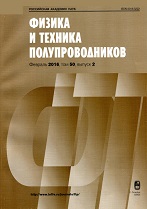|
|
Fizika i Tekhnika Poluprovodnikov, 2016, Volume 50, Issue 4, Pages 474–484
(Mi phts6489)
|
 |
|
 |
This article is cited in 1 scientific paper (total in 1 paper)
Semiconductor structures, low-dimensional systems, quantum phenomena
Sulfur passivation of semi-insulating GaAs: transition from Coulomb blockade to weak localization regime
N. T. Bagraevab, E. I. Chaikinac, E. Yu. Danilovskiia, D. S. Getsa, L. E. Klyachkina, T. V. L'vovaa, A. M. Malyarenkoa
a Ioffe Institute, St. Petersburg, Russia
b Peter the Great St.Petersburg Polytechnic University, St. Petersburg, Russia
c Division de Fısica Aplicada, Centro de Investigación Científica y de Educación Superior de Ensenada, Ensenada, Mexico
Abstract:
The sulfur passivation of the semi-insulating GaAs bulk (SI GaAs) grown in an excess phase of arsenic is used to observe the transition from the Coulomb blockade to the weak localization regime at room temperature. The I–V characteristics of the SI GaAs device reveal nonlinear behavior that appears to be evidence of the Coulomb blockade process as well as the Coulomb oscillations. The sulfur passivation of the SI GaAs device surface results in enormous transformation of the I–V characteristics that demonstrate the strong increase of the resistance and Coulomb blockade regime is replaced by the electron tunneling processes. The results obtained are analyzed within frameworks of disordering SI GaAs surface that is caused by inhomogeneous distribution of the donor and acceptor anti-site defects which affects the conditions of quantum-mechanical tunneling. Weak localization processes caused by the preservation of the Fermi level pinning are demonstrated by measuring the negative magnetoresistance in weak magnetic fields at room temperature. Finally, the studies of the magnetoresistance at higher magnetic fields reveal the $h/2e$ Aharonov–Altshuler–Spivak oscillations with the complicated behavior due to possible statistical mismatch of the interference paths in the presence of different microdefects.
Keywords:
GaAs, Versus Characteristic, Gate Voltage, Weak Magnetic Field, Negative Differential Resistance.
Received: 06.10.2015
Accepted: 06.10.2015
Citation:
N. T. Bagraev, E. I. Chaikina, E. Yu. Danilovskii, D. S. Gets, L. E. Klyachkin, T. V. L'vova, A. M. Malyarenko, “Sulfur passivation of semi-insulating GaAs: transition from Coulomb blockade to weak localization regime”, Fizika i Tekhnika Poluprovodnikov, 50:4 (2016), 474–484; Semiconductors, 50:4 (2016), 466–477
Linking options:
https://www.mathnet.ru/eng/phts6489 https://www.mathnet.ru/eng/phts/v50/i4/p474
|


| Statistics & downloads: |
| Abstract page: | 26 | | Full-text PDF : | 11 |
|





 Contact us:
Contact us: Terms of Use
Terms of Use
 Registration to the website
Registration to the website Logotypes
Logotypes








 Citation in format
Citation in format 
